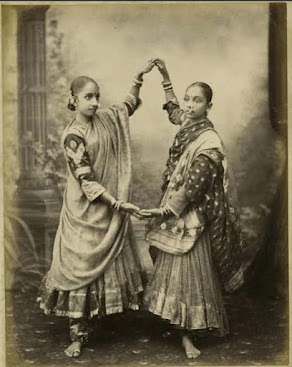Courtesans - the visible exponents of music and dance
"Ghoor ghoor barasat meharava, bijuriya chamaki anek baar (The lightning flashed many times and the rains poured from the sky)."
The melody still echoes the journey of a Tawaif who has always been disgraced by many indecent adjectives in our society. The first word which comes in our mind by hearing the word "Tawaif" is a Kothewali, a gaanewali, a prostitute, a whore! But let me bestow you with some insights in history when tawaifs were seen as greatest epitome of etiquette and culture. But prior to that, let me tell you what it meant to be a "tawaif"?
In the subcontinent, Tawaif referred to the courtesans who were proficient and highly skilled in both music and dance and were at the center of art and culture in India. They were the entertainers of the royal court and nobility, and only the wealthy and elite could afford to attend their concerts. The Tawaif were considered authorities on etiquette, so much so that noble families would send their sons to them to learn the art of conversation and etiquette.
The Courtesans not only collected art but also produced in assisting and developing arts. The time, when most of the women were in purdah, these women employed male musicians. They were hosting the perfect "mehfil" and needless to mention, it required proper usage of Urdu words, which many of us fail to do even now.
"Chup chup aahein bharna kya" has been with us since ages now but India has often appropriated and seldom appreciated the courtesans. Courtesans have been unfairly overlooked in discussions of Indian culture, even though they were tremendously influential and important artists in the arenas of music, dance, poetry and theater, yet courtesans have contributed greatly to the performing arts in India—their contributions enriched these fields immensely. Women from courtesan lineages, who carry with them the stigma of being from such a lineage, have been stripped of their status and stigmatized by notions of respectability. This impacts not only their livelihoods but their entire lives.
The ashes on which our most popular, highly nostalgic film representations of "Tawaifs" are built is not the reality, in some senses. The real-life stories they erase are the ones we must now seek out, more than ever before.
In Bhansali's Devdas, we hear a dialogue "Jo aurat kuch nahi hoti voh tawaif hoti hai"... Perhaps it is time to revise our attitude toward tawaifs, as well as women in general. After all, women are not merely the identities they take on; they have their own sense of identity. When they aren't bound by any role, they can be at their best—being women, responding to the feminine principle, forging an identity that they truly own.




Comments
Post a Comment